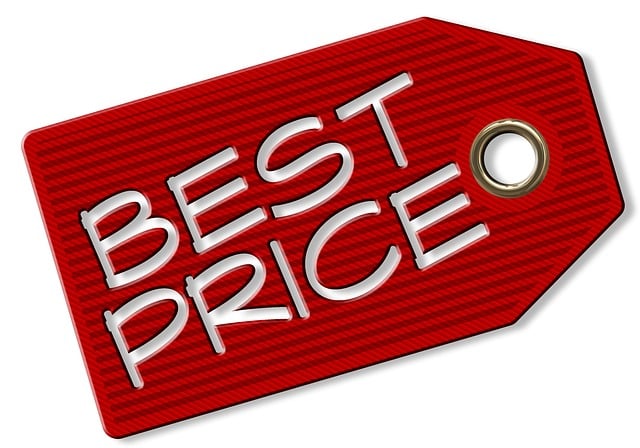E-commerce pricing strategies rely on understanding customer demand elasticity and competitive market forces. Dynamic pricing adjusts prices in real-time based on demand and competitor analysis, maximizing profits. Bundle offers and discounts optimize prices during peak seasons while maintaining profitability. Personalized pricing uses data to set tailored prices for individual customers. Regular pricing audits ensure prices remain competitive and aligned with business goals.
In the competitive landscape of e-commerce, effective price optimization is key to achieving both sales growth and profitability. This article explores powerful techniques to help businesses maximize revenue. We delve into understanding customer elasticity and price sensitivity, conducting competitive analysis for optimal pricing, implementing dynamic pricing strategies, leveraging bundle offers, personalizing prices based on data, and the importance of regular pricing audits. Discover how these tactics can optimize your pricing strategy and boost your bottom line.
- Understanding Customer Elasticity and Price Sensitivity
- Competitive Analysis: Benchmarking for Optimal Pricing
- Dynamic Pricing Strategies for Real-Time Optimization
- Bundle and Discount Offers: Driving Sales and Profitability
- Personalized Pricing: Leveraging Customer Data
- Regular Pricing Audits for Continuous Improvement
Understanding Customer Elasticity and Price Sensitivity

Understanding customer elasticity and price sensitivity is paramount for e-commerce businesses aiming to optimize their pricing strategies. Customer elasticity refers to how responsive demand is to changes in price, with some products or services exhibiting higher elasticity than others. For instance, a luxury item might have low elasticity, meaning customers are less likely to switch brands or purchase alternatives when the price increases. In contrast, a commodity with high elasticity will see a significant drop in sales if prices rise, as consumers seek cheaper alternatives.
Price changes and consumer behavior are intricately linked, and businesses must manage discounts and promotions strategically. A simple cost-plus pricing strategy, where the final price is calculated by adding a markup to the product’s cost, can be effective for certain products. However, in dynamic e-commerce environments, where competition thrives, managing prices through promotions and sales events can drive customer engagement. By carefully analyzing consumer behavior and adjusting prices accordingly, businesses can maximize profits and remain competitive, ensuring a successful online presence that satisfies both customers and the bottom line. Visit us at [fixed costs explanation] for more insights into pricing optimization strategies.
Competitive Analysis: Benchmarking for Optimal Pricing

Competitive analysis is a powerful tool for e-commerce businesses looking to optimize their pricing strategies. By benchmarking your prices against those of competitors, you gain valuable insights into market trends and customer expectations. This process involves a thorough price analysis that includes examining various pricing models adopted by industry leaders and direct competitors. Understanding these models, such as the cost-plus pricing strategy, allows for strategic adjustments to align with your business goals.
Effective competitive analysis enables you to identify gaps in the market, set prices that reflect your unique value proposition, and stay ahead of the curve. It’s not just about matching competitor prices but ensuring your pricing structure remains dynamic and responsive to changes in the e-commerce landscape. Utilize price optimization tools to streamline this process, enabling you to make data-driven decisions and adjust pricing strategies with precision. Visit us at discounts and promotions management anytime for more insights on staying competitive in today’s market.
Dynamic Pricing Strategies for Real-Time Optimization

In today’s dynamic e-commerce landscape, successful businesses understand that price optimization is key to staying competitive. Dynamic Pricing Strategies offer real-time adjustments based on market demand, ensuring prices reflect current customer behavior and trends. This approach allows retailers to adapt swiftly, maximizing profits during peak periods while providing attractive discounts when sales are slower. By continuously analyzing data on product performance, customer interactions, and external factors like competitor pricing, businesses can make informed decisions on price changes.
A critical component of this strategy is the cost-volume-profit analysis, which helps in understanding how different prices impact sales volume and profitability. This analysis, combined with a robust find us at competitive analysis for pricing, enables retailers to craft effective price strategies that cater to both customer expectations and business goals. For monopolies or products with limited substitutes, a well-designed price strategy can further solidify market position while ensuring sustainability in the long term.
Bundle and Discount Offers: Driving Sales and Profitability

Bundle and Discount Offers are powerful tools for e-commerce businesses to optimize their prices and boost sales, especially when navigating the complexities of the elasticity of different goods. During peak seasons or to clear inventory, offering bundled items at a lower collective price than individual items can attract price-conscious consumers. This strategy leverages the interdependence of goods, where customers might be more inclined to purchase multiple related products at once. For instance, a clothing store could bundle a shirt and pants at a discounted rate, enticing buyers who want both pieces but may have hesitated due to individual prices.
Moreover, discount offers can range from percentage off sales to buy-one-get-one promotions, providing flexibility in price optimization tools that cater to various business needs. However, it’s crucial to balance these strategies with the goal of maintaining profitability. While driving short-term sales, excessive discounts might negatively impact long-term revenue. Therefore, businesses must carefully consider the determining fair price approach for each promotion, especially when competing in price wars: causes and impacts. Staying attuned to market trends, customer behavior, and product margins ensures that bundle and discount offers effectively enhance profitability rather than undermining it.
Personalized Pricing: Leveraging Customer Data

Personalized pricing is a powerful strategy for e-commerce businesses to maximize profits and enhance customer satisfaction. By leveraging customer data, retailers can tailor prices based on individual preferences, purchase history, and behavior patterns. This approach allows for more precise targeting of customers, ensuring that each buyer perceives a unique value proposition. For instance, sending targeted promotions to specific customer segments can increase engagement and sales.
When implementing personalized pricing, understanding the legal aspects of price discrimination is crucial. While dynamic pricing, based on real-time demand and customer behavior, is a legal practice, retailers must be mindful of anti-competitive practices and ensure that their pricing strategies adhere to market regulations. Conducting competitive analysis for pricing involves studying competitors’ strategies, allowing businesses to set prices that are both profitable and in line with industry standards, thus maintaining a healthy balance between revenue generation and customer retention. Additionally, determining a fair price considers various factors such as production costs, market trends, and consumer expectations, ensuring sustainable business practices.
Regular Pricing Audits for Continuous Improvement

Regular Pricing Audits are an indispensable tool for e-commerce businesses aiming to stay competitive and maximize profits. By conducting thorough price analysis at regular intervals, retailers can identify inefficiencies, uncover pricing trends, and make data-driven adjustments. This continuous improvement process involves examining every aspect of the product lifecycle, from initial sourcing to market fluctuations, ensuring prices remain aligned with both customer expectations and operational costs.
Through such audits, businesses can refine their budgeting and pricing strategies, adapting them to evolving consumer behaviors and industry standards. For instance, a price analysis might reveal opportunities to adjust pricing during peak seasons or identify products where strategic markups or discounts could enhance sales. Moreover, staying agile with pricing allows e-commerce enterprises to find us at various pricing strategies across industries, ultimately driving revenue growth while maintaining customer satisfaction.
Optimizing prices is a strategic imperative for e-commerce success. By understanding customer elasticity, conducting competitive analyses, implementing dynamic pricing, leveraging bundle offers and personalized pricing, and performing regular audits, businesses can effectively navigate market dynamics and maximize profitability. These strategies empower retailers to set prices that not only drive sales but also foster customer loyalty and sustain growth in today’s competitive digital landscape.





Leave a Reply